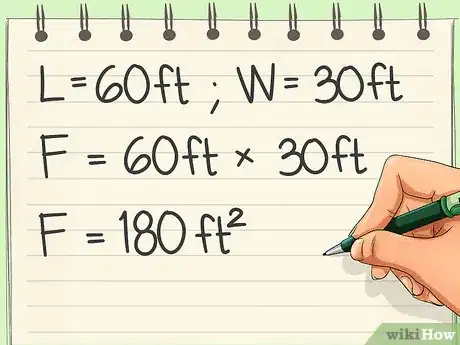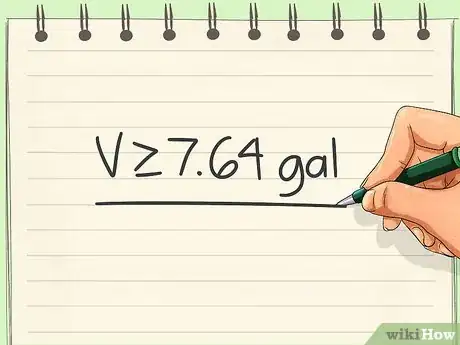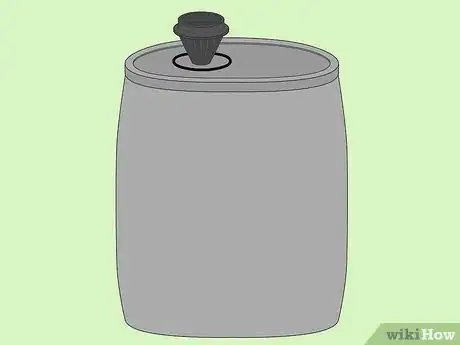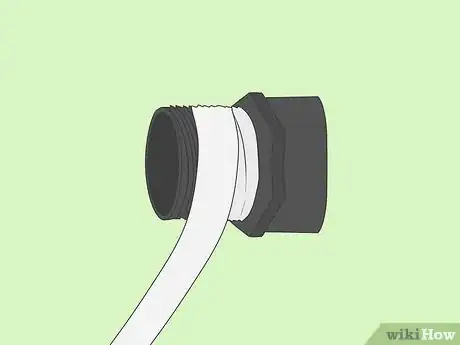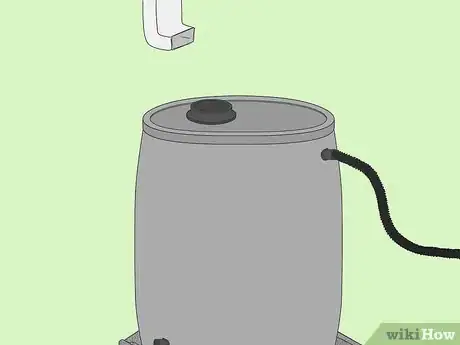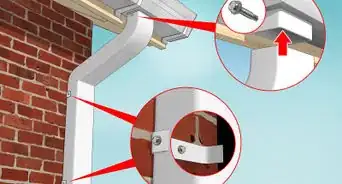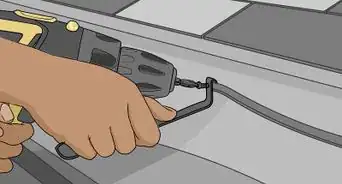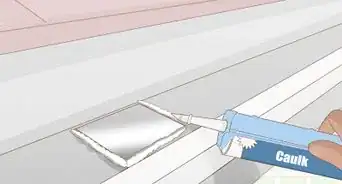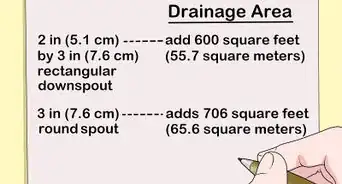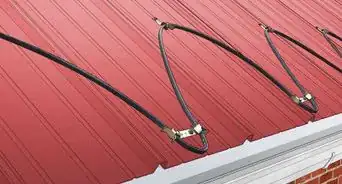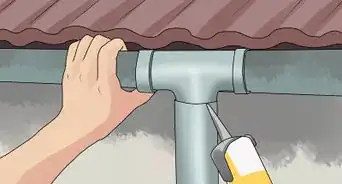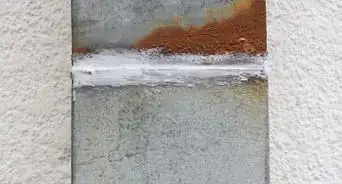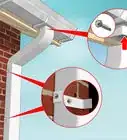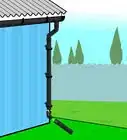wikiHow is a “wiki,” similar to Wikipedia, which means that many of our articles are co-written by multiple authors. To create this article, volunteer authors worked to edit and improve it over time.
This article has been viewed 26,959 times.
Learn more...
Rain Barrels store and reuse rainwater, helping to reduce the overtaxing of sewer systems and protect the quality of groundwater. A simple rain catchment system can provide water for outdoor use, resulting in a lower water bill. Anyone can begin the process of turning a home or business green by making and installing a basic rain barrel. The system outlined below will walk you through the steps of determining your rain barrel sizes based on average roof runoff. Also outlined are the steps to build your own rain barrel to collect water from your roof and downspout for all outdoor uses like watering and cleaning. For sample purposes, a 55-gallon barrel will be used.
Steps
Calculating Runoff
-
1Determine the footprint of your structure (F) in square feet:
- Measure along the length of the house or building and along the width of the house or building (in feet).
- Multiply the two figures together to obtain the square footage of your roof.
-
2Determine the percentage of water collected from each downspout (P).
- Count the number of downspouts coming from your roof.
- Divide 100 by the number of downspouts in order to obtain the percentage of water collected from each downspout.
- Convert the percentage to a decimal by dividing the percentage by 100.
Advertisement -
3Calculate the area of square footage that each downspout will be collecting from in a rainfall (A).
- Multiply the area of your roof by the total obtained in step 2, as outlined in the following equation: F x P = A
-
4Estimate the rainfall per event in your area (R) by dividing the annual precipitation rate by the number of rain days per year. For example, if it rained 35.4 inches in 2010, with 129 calculated days of rainfall, you would divide 35.4 by 129 to get the average of .274 inches per event.
-
5Calculate the volume of water each downspout will collect in a rainfall by using the following equation: A x R x 0.62 = V (Volume in gallons)
-
6Calculate the average annual runoff coming out of each downspout (R1) by using the following equation: A x R1 x .062 = V
-
7Determine the gallon size of your rain barrel based on the calculations obtained from steps 6 and 7. Depending on the amount of rainfall which will be collected annually from your rooftop, you may opt to build and attach multiple rain barrels.
Building a Rain Barrel
-
1Clean the rain barrel by mixing the castile soap and lemon juice together. Rinse thoroughly afterwards.
-
2Using the felt tip pen, trace the circular outline of the atrium grate on top of the barrel. Use the top part of the grate to trace; make sure no part of the circle is closer than 4 inches to the edge of the barrel.
-
3Use the utility knife to cut along the traced line, creating a hole in the lid. Be sure to cut as close to the trace as possible, allowing for a snug fit of the atrium gate to the hole.
-
4Place the atrium grate in the hole, filter side into the barrel, and twist lightly to secure in place.
-
5Determine where you want to place your spigot hole, and mark it with your felt tip. This should be approximately 2 inches up from the bottom of the rain barrel. Mark a spot for your overflow, approximately 2 inches from the top of your barrel and 90 degrees to the right or left of the spigot hole.
-
6Use the 29/32 inch drill bit to drill the overflow and spigot holes.
-
7Attach a sump pump drain kit to more accurately direct your overflow.
- Using your file, work along the edges to expand the hold to approximately 29/32 of an inch. (Use your drill bit to gauge the size. It should fit snugly in the hole.)
- Attach a ¾ inch male PVC adapter from the outside of the overflow hole to a ¾ inch female adapter on the inside of the hole. To do this, attach the female to male adapter, and twist the male adapter through the hole.
- Caulk the inside and outside of the holes with silicone caulk, and allow 20-30 minutes to set.
- Place the sump pump hose onto the male adapter on the overflow hole to redirect the water.
-
8Use plumbing tape to wrap a ¾ inch PVC male adapter threads so there are no threads exposed. Three times around the threads should be sufficient.
-
9Secure the spigot to the adapters.
- Place the adapter inside the barrel by setting the threaded end of the adapter through the hole and screwing the two parts together. The spigot should be tight to the barrel.
-
10Use the silicone caulk to seal around the inside and the outside of the spigot hole by tracing a ¼ inch thick line of caulk along the edge of the spigot and around the interior adapter. Allow 20-30 minutes for the caulk to set.
-
11Locate a level spot underneath a downspout, and place the concrete blocks lengthwise next to each other under the downspout. Position the rain barrel centered on top of the blocks. This will allow you room to access the spigot. You may create a more stable “pad” by stacking 16 blocks, alternating directions.
-
12Measure and mark the downspout 4” above the top of the rain barrel, and use the hacksaw to cut the downspout fitting.
-
13Crimp the end of the elbow using the pliers. To do so, grasp the edge of the elbow with the pliers and bend the edges of the elbow opening inward.
-
14Insert the 90 degree elbow into the existing downspout, and secure in place by wrapping the overlapping edges with plumbing tape. Be sure to position the elbow over the atrium grate.
-
15Attach the elbow by using the ¼” screw bit to screw the zip screws into the overlapped fittings. Attach one screw to the front and to each side. Remove the plumbing tape once the elbow has been secured in place.
Warnings
- Do not use barrels that previously stored chemicals.⧼thumbs_response⧽
- Do not use water collected in rain barrels for consumption. Water contains pollutants, algae and other materials. Water requires purification or boiling in order to consume.⧼thumbs_response⧽
- Full rain barrels weigh in excess of 400 pounds when full. Using a level location helps to ensure stability.⧼thumbs_response⧽
Troubleshooting
- Issue: Muddied water from dead leaves and twig debris. Solution: If too much debris is entering the barrel, fit a mesh screen over the end of the downspout which feeds into the atrium grate.
- Issue: Water drains slowly or not at all from spigot. Solution: Check the atrium grate to make sure nothing major is obstructing the flow of water to your barrel. If the problem persists, make sure the atrium grate is large enough to handle the flow of water from the downspout. If you are in an area which collects more rainfall than your atrium can handle, increase the atrium size.
- Issue: Algae forming of the water surface. Solution: Add a cap or two of bleach and let it stand for several days prior to use. You may also empty you barrel once a month to keep it clean.
Things You'll Need
Materials
- Measuring tape
- 55-gallon food grade plastic barrel
- 1 cup castile soap
- 1 cup lemon juice
- ¾ inch copper water faucet
- Two ¾ inch PVC male adapter
- ¾ inch PVC female adapter
- 6 inch atrium grate
- Plumbing tape
- All-purpose caulk
- ¾ inch 90 degree galvanized downspout elbow
- Three 3/8 inch zip screws
- Four or sixteen standard concrete masonry blocks (depending on option used), 7 5/8 x 7 5/8 x 15 5/8
Tools
- Hacksaw
- Electric drill
- ¼ inch screw bit
- 29-32 inch drill hole saw bit
- Flat-nose pliers
- Felt tip pen
- Utility knife
- Tapered round file
